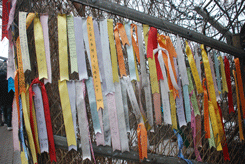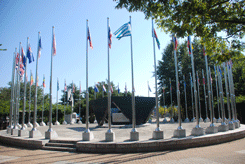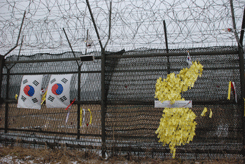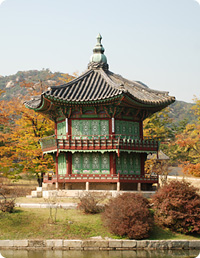DAY
The 3rd Tunnel / 6 hours



Tour Highlights
- Mangbaedan Altar
- Freedom Bridge
- Locomotive Engine
- Peace Stones
- Peace Bell
- The 3rd Tunnel
- Dora Observatory
Seoul - DMZ - Seoul (- - -) 140km
Please note that the DMZ is a politically sensitive area, and is therefore not always open to tourists.
In the event that the area cannot be visited, alternate sightseeing will be arranged (DMZ Gondola, Imjingak tour, and Odusan Observatory)
Rules and Regulations |
 Your touring today will be private until you reach Imjingak, at which time you will board a bus with other tourists as private tours of the tunnel and DMZ area are not allowed. Your private tour guide will remain with you throughout the day.
Your touring today will be private until you reach Imjingak, at which time you will board a bus with other tourists as private tours of the tunnel and DMZ area are not allowed. Your private tour guide will remain with you throughout the day.
On the way, you will drive the highway that is lined on one side with barbed wire and frequent guard stations spaced along the river that makes up part of the border.
Imjingak is the furthest north point in the area than you can go freely, and a park with an array of monuments and statues that speak to the Korean War (1950-1953).
One such monument is Mangbaedan, a memorial site where displaced North Koreans pray for their ancestors. Near Mangbaedan is the Freedom Bridge, and was an important site where 12,773 prisoners of war returned to freedom. This short, sturdy wooden structure ends at a barricade, which embodies the North. The altar and the bridge now serve as places of remembrance for displaced families, and the millions of bright colored ribbons tied to the fence have messages of hope, dreams and wishes for unification between South and North Korea.
Stop at a derelict locomotive engine shot full of bullet holes and its bent wheels - not particularly special in any way other than it shows the destruction of war. Having been left in the DMZ since bombs derailed it during the Korean War; it was cleaned up and moved here in 2009. There is a collection of stones from 86 battlefields in 64 countries known as the Peace Stones that have witnessed suffering and grief of war. You will also see them.
Then, you board a tour bus to continue on to the Demilitarized Zone which straddles the South and North Korean border. A 4km wide buffer of land stretches the breadth of the Korean peninsula. Total 1,292 signboards of the Military Demarcation Line were established and 696 of which are controlled by the U.N. Forces while 596 are under the control of North Korea and China. Although an Armistice came into effect in July 1953, the two Koreas are still technically in an active state of war. Tensions between the two countries remain high, and the border is patrolled by thousands of troops on both sides. Before being allowed to enter the DMZ, you will have to obtain passport and security clearance at the Unification Bridge, the first control line with sentries and photo opportunities will be limited.
Venturing into The 3rd tunnel, running across the North Korean border, to explore one of the four infiltration tunnels dug by the North. Discovered on October 17, 1978, it is a 1,635m long, 2m high and 2m wide, and could have accommodated 30,000 soldiers per hour in what was apparently designed for a surprise attack on Seoul. The tunnel runs through bedrock at a depth of about 73m below ground; 435m of which are found in the South over the Military Demarcation Line (MDL). It is designed at a three thousandth angle with northern side lower than southern side, so that water does not stagnate inside tunnel. After ducking and crouching your way 265m through the tunnel, you will reach one of the cement walls with iron door near the MDL that will prevent you from going any further north and where you peep through a small window at a barricade, just to see another barricade in the distance. You can clearly see the drill marks for dynamite all pointing toward the South. This finding, along with other clues, clearly affirmed their construction.
Then, make your way to the DMZ Theater. You will have an opportunity to watch a short video including old film that takes you back in time to the signing of the armistice and the creation of the DMZ. The video provides a South Korean perspective on the Korean War, how the DMZ came about, and today’s current situation. It also gives some background to the infiltration tunnels that North Korea dug.
At DMZ Exhibition Hall, you will see some key artefacts to give you a better understanding of Korea's bitter history. Containing photos, documents, and some remnants from the past, a walk through the Exhibition Hall will provide you with a deeper and more visual knowledge of the conflict. There are many exhibits on display and some interesting facts for history buffs.
Next stop is Dora Observatory. Sitting at the top of Dorasan, the Observatory is ideal for looking across the border. This is the part closest to the North in the South that allows tourists to get their closest glimpse of North Korea. Here, visitors can view full expanse of Demilitarized zone including two heavily guarded villages in the DMZ, Daeseongdong farming community in the south and Gijeongdong propaganda village in the north, which face each other across the minefields. Each village hangs their government's flag upon some of the tallest flagpoles in the world - what some have come to call the "flagpole war." In 1981, the South Korean government built a 99.8m-tall flagpole with a 130kg (18m x 12m) South Korean Flag. The North responded by building a 160m-tall flagpole with a 270kg (30m x 14m) flag. It was superseded as the world's tallest, following the construction of the flagpole in Baku's National Flag Square at 162m. Both flagpoles were topped in 2011 by the Dusanbe Flagpole in Tajikistan at 165m.






